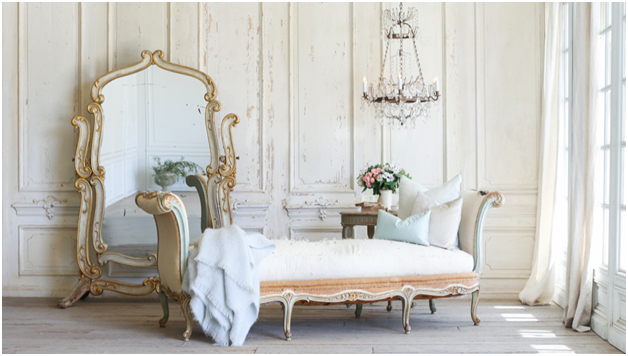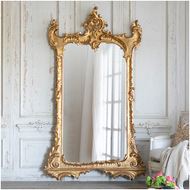French Furniture Styles: Historical Timeline & Key Highlights
Dec 23rd 2021
When it comes to styles of furniture, there are countless enamoring options on the market today. Each one can bring a specific aesthetic element to any space it is placed in, matching your overall visionary interior design goals.
While the more modern furniture styles of today, like Scandinavian contemporary and urban collective, can be truly inspiring in their own right, the more “classic” options continue to astound us all. Antiques and vintage pieces are amongst those options, but this is especially true for French furniture.
French furniture provides a uniquely calming and inviting element to any room it is found in. However, there are numerous types of this particular type of furniture that anyone looking to utilize it to their advantage should be aware of. Before finding the perfect piece for you, you should have a general understanding of the history of furniture in France and how each style is different from the next.
Let’s take a look at the timeline of French furniture styles, then the most popular of these styles and their key characteristics.
1.Medieval (1300-1500)
2.Renaissance (1500-1610)
3.Louis XIII (1589-1661)
4.Louis XIV (1661-1700)
5.Le Regence (1700-1730)
6.Louis XV (1730-1760)
7.Louis XVI (1760-1789)
8.Directoire (1789-1804)
9.Empire (1804-1815)
10.Restauration (1815-1830)
11.Louis Philippe (1830-1848)
12.Second Empire/Napolean III (1848-1870)
13.Style Moderne and Art Nouveau (1889-1925)
14.Art Deco (1925-1935)
While each and every French style of furniture in this timeline has its own unique qualities, there are some that undoubtedly stand out in popularity than others. Let’s investigate six of the most well-known and influential furniture styles from France and what makes them so particularly inspirational and enchanting.
1.Le Regence (1700-1730)
Le Regence was a movement of furniture in France that roughly reigned from 1700 to 1730. Because Louis XV was much too young to rule in 1715, the country was instead ruled by a regent named Philippe d’Orléans (hence the name of the movement as “Le Regence”). While the regency began in 1715, the style movement began several years beforehand.
During this time, Baroque and Rococo gained massive popularity throughout the country. Rococo in particular reached other countries as well, such as Italy and Germany.
Le Regence furniture focused heavily on comfort, elegance, and intimacy. The lines of the pieces became more curved while the pieces’ sizes overall contracted. They used gilt bronze and wood marquetry for decoration.
2.Louis XV (1730-1760)

Louis XV finally came into power without his regent starting in 1723 and reigned for a grand total of 59 years (including the years with his regent). His time on the throne was a memorable one, as it led to unequivocally high French culture and influence. Although his reign did inevitably lead to the French Revolution in 1789 (postmortem), his effect on French furniture style was something of a particular marvel.
This furniture style was elegant yet practical and far more transportable than before. New pieces were added, such as chiffoniers, roll-top desks, and dressing tables. All the pieces have long been merited for their feminine, romantic, and ornate facades.
The pieces in this style utilized more moderately curved lines, while the upholstery was specifically made to both look exquisite and feel so upon use. The motifs ranged in images, which included females faces and various flora and fauna.
3.Louis XVI (1760-1789)

In the style of Louis XVI, who was the final king of France and ruled from 1774 to 1792, furniture ebbed more on the rustic side. This “rustic” look was emblemized by the mahogany, which was so evidently used throughout the period.
While Louis XV popularized the use of curved lines and more subtle features, Louis XVI brought back the harder lines along with the right angles that were previously softened. “Classical” remembrances had reemerged, which was prominent in the motifs that had returned to human faces and florals. Legs of various pieces were tapered. Geometry played a large role in the design of this furniture style.
4.Directoire (1789-1804)
The Directoire period was a transitional one, for not only French furniture but also the country as a whole. The monarchy was rid of and replaced with a government of Directors (hence the name of the period as “Directoire”). Because of this, countless parts of the French culture were changed, including the furniture.
Splendor vanished from various parts of the country, including the furniture. Neoclassical elements returned during this tumultuous time in French history. Furniture pieces afforded various symbolic parts which resembled the French Revolution, like clasped hands for fraternity and pikes for the freedom of man.
Because extravagance was rid of, these pieces often were more affordable and less ornate. However, inlay decorations did have a bit of a boost in prevalence.
5.Empire (1804-1815)
Empire was a period that continued to use Neoclassical elements in their furniture pieces but in a far more elegant and entrancing manner. It began in 1804, the year that Napoleon Bonaparte was self-crowned as emperor of France. This style boasted Napoleonic France’s imperial majesty.
These pieces had far more grandeur than the previous period and the pieces were more consistent in quality and look. This style afforded symmetrical ornamentation while surfaces were quite flat and had some sharp angles. However, this style was so beloved that it remained popular even decades after Napoleon’s downfall.
6.Restauration (1815-1830)
While the Empire style had intrinsic qualities, one issue that befell it was its discomfort. During the Restauration period, that issue was properly rectified. The Bourbon kings ruled France once more, so a return to their former lifestyles was heavily strived for during this period, including comfort.
The motifs were far more decorative, which typically had images such as garlands, swans, cornucopia, and musical instruments. Overall, these pieces were quite portable while offering a humble symphony between elegance and modesty.
The styles and movements of French furniture all remain special and stunning in their own ways. If you are looking to add French antique or vintage styles to your home or office, be sure to investigate our offerings here at Eloquence. We not only have plenty of authentic antique and vintage pieces but also re-editions that have been carefully crafted by our skilled craftsmen.


